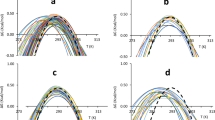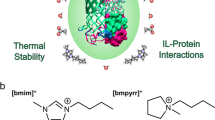Abstract
Nonaqueous co-solvents, particularly 2,2,2-trifluoroethanol (TFE), have been used as tools to study protein folding. By analyzing FKBP12, an α/β-protein that folds with two-state kinetics, we have been able to address three key questions concerning the use of TFE. First, does TFE perturb the folding pathway? Second, can the observed changes in the rate of folding and unfolding in TFE be attributed to a change in free energy of a single state? Finally, can TFE be used to infer information on secondary structure formation in the transition state? Protein engineering experiments on FKBP12, coupled with folding and unfolding experiments in 0% and 9.6% TFE, conclusively show that TFE does not perturb the folding pathway of this protein. Our results also suggest that the changes in folding and unfolding rates observed in 9.6% TFE are due to a global effect of TFE on the protein, rather than the stabilization of any elements of secondary structure in the transition state. Thus, studies with TFE and other co-solvents can be accurately interpreted only when combined with other techniques.
This is a preview of subscription content, access via your institution
Access options
Subscribe to this journal
Receive 12 print issues and online access
$189.00 per year
only $15.75 per issue
Buy this article
- Purchase on Springer Link
- Instant access to full article PDF
Prices may be subject to local taxes which are calculated during checkout



Similar content being viewed by others
References
Fersht, A.R., Matouschek, A. & Serrano, L. J. Mol. Biol. 224, 771– 782 (1992).
Itzhaki, L.S., Otzen, D.E. & Fersht, A.R. J. Mol. Biol. 254, 260– 288 (1995).
Chen, B., Baase, W.A. & Schellman, J.A. Biochemistry 26, 691– 699 (1989).
Tanford, C. Adv. Prot. Chem. 23, 121–282 (1968).
Tanford, C. Adv. Prot. Chem. 24, 1–95 (1970).
Chiti, F. et al. J. Mol. Biol. 283, 883– 891 (1998).
Chiti, F. et al. Nature Struct. Biol. 6, 380– 387 (1999).
Blanco, F., Rivas, G. & Serrano, L. Nature Struct. Biology 1, 584 –590 (1994).
Jasanoff, A. & Fersht, A.R. Biochemistry 33, 2129–2135 (1994).
Schonbrunner, E.R., Wey, J., Engels, J., Georg, H. & Kiefhaber, T. J. Mol. Biol. 260, 432– 445 (1994).
Hamada, D. & Goto, Y. J. Mol. Biol. 269, 479–487 (1997).
Kentsis, A. & Sosnick, T.R. Biochemistry 37, 14613–14622 (1998).
Lu, H., Buck, M., Radford, S.E. & Dobson, C.M. J. Mol. Biol. 265, 112–117 ( 1997).
Zerovnik, E., Virden, R., Jerala, R., Turk, V. & Waltho, J.P. Proteins 32, 296– 303 (1998).
Fulton, K.F., Main, E.R.G., Daggett, V. & Jackson, S.E. J. Mol. Biol. 291, 429–444 (1999).
Main, E.R.G., Fulton, K.F. & Jackson, S.E. J. Mol. Biol. 291, 445– 461 (1999).
Ionescu, R.M. & Matthews, C.R. Nature Struct. Biol. 6, 304–307 (1999).
Walgers, R., Lee, T.C. & Cammers-Goodwin, A. J. Am. Chem. Soc. 120, 5073– 5079 (1998).
Storrs, R.W., Truckses, D. & Wemmer, D.E. Biopolymers 32, 1695– 1702 (1992).
Luidens, M.K., Figge, J., Breese, K. & Vajda, S. Biomolecules 39, 367–376 (1996).
Wang, A. & Bolen, D.W. Biochemistry 36, 9101–9108 (1997).
Main, E.R.G., Fulton, K.F. & Jackson, S.E. Biochemistry 37, 6145– 6153 (1998).
Acknowledgements
S.E.J. is a Royal Society University Research Fellow and E.R.G.M. is supported by a BBSRC studentship. We thank F. Chiti and C. Dobson for helpful discussions.
Author information
Authors and Affiliations
Corresponding author
Rights and permissions
About this article
Cite this article
Main, E., Jackson, S. Does trifluoroethanol affect folding pathways and can it be used as a probe of structure in transition states?. Nat Struct Mol Biol 6, 831–835 (1999). https://doi.org/10.1038/12287
Received:
Accepted:
Issue Date:
DOI: https://doi.org/10.1038/12287
This article is cited by
-
GaMD simulations as an alternative in the TFE-water mixture description
Journal of Molecular Modeling (2023)



